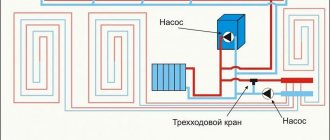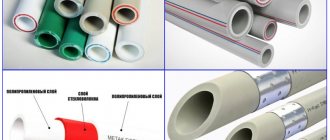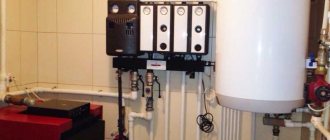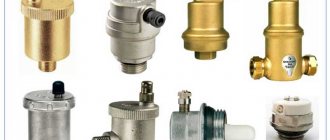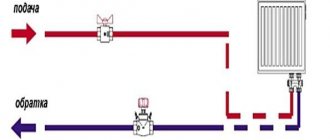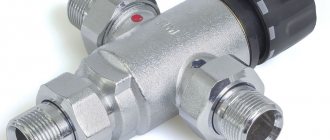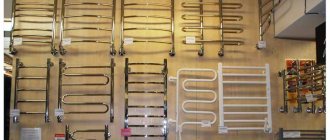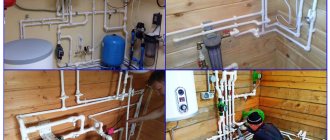In the question: what should be the pressure in the heating system in a private house - every homeowner should have a good understanding.
After all, not only the efficiency and performance of the circuit, but also its integrity depends on this parameter.
In this article we will consider this issue in detail and understand the reasons for the deviation of pressure from the norm.
What pressure in the heating system of a private home is considered normal?
So, what pressure should be in the heating system?
First of all, you need to know that the pressure in any heating system should not exceed the strength threshold of its weakest component.
Typically these are boiler heat exchangers.
The most durable of them can withstand pressures of up to 3 atmospheres or bar.
Pressure is often indicated in MPa (megapascal). The correspondence of the values is as follows: 1 atm = 0.1 MPa.
Fittings and radiators are generally more durable. For example, a cast iron radiator can withstand a pressure of 6 atm.
The answer to the question of what pressure can be considered normal for a particular heating system will depend on its type. The simplest type is systems with natural circulation of coolant, also called thermosiphon. In such a circuit, the coolant moves only due to convection. This phenomenon is caused by gravity, which is why such systems are also called gravitational.
The pressure in a thermosiphon system depends only on the height of the water column, that is, on the difference in height between the lowest and highest points. This pressure is called static. A height difference of 10.34 m creates a pressure of 1 atm at the lowest point. Thus, a boiler tank designed for 3 atm can only collapse if the system rises 10.34 x 3 = 31.02 m above it.
Heating system with expansion tank
Once again, we draw the reader’s attention to the fact that the static pressure in the heating system is maximum only at the lowest point. In the direction from bottom to top, it gradually decreases and at the top point it becomes equal to zero.
The actual pressure at the top point of the liquid volume is equal to atmospheric pressure, but we are interested in the so-called excess pressure - it is precisely this that is equal to zero.
Since there is no excess pressure at the top point of the circuit, the expansion tank installed here can look like a simple open container. Therefore, such systems are also called open.
If the heating system is equipped with a circulation pump that pumps coolant, it must be made closed.
Why raise the pressure?
The pressure in the supply line is higher than in the return line. This difference characterizes the heating efficiency as follows:
- A small difference between the supply and return makes it clear that the coolant successfully overcomes all resistance and transfers the calculated amount of energy to the premises.
- An increased pressure drop indicates increased section resistance, decreased flow velocity and excessive cooling. That is, there is insufficient water flow and heat transfer to the rooms.
For reference. According to the standards, the optimal pressure difference in the supply and return pipelines should be in the range of 0.05–0.1 Bar, maximum 0.2 Bar. If the readings of 2 pressure gauges installed on the line differ more, then the system is not designed correctly or needs repair (flushing).
To avoid high drops on long heat supply branches with a large number of batteries equipped with thermostatic valves, an automatic flow regulator is installed at the beginning of the line, as shown in the diagram.
So, excess pressure in a closed heating network is created for the following reasons:
- to ensure forced movement of the coolant at the required speed and flow rate;
- to monitor the condition of the system using a pressure gauge and recharge or repair it in time;
- Coolant under pressure heats up faster, and in the event of emergency overheating, it boils at a higher temperature.
We are interested in the second item on the list - the pressure gauge readings as a characteristic of the serviceability and performance of the heating system. They are of interest to homeowners and apartment owners who independently maintain home communications and equipment.
Pressure in a closed heating system
The circulation pump creates increased pressure in the section of the pipeline located behind it, thereby providing a number of advantages:
- The maximum length of the circuit becomes virtually unlimited (for a circuit with natural circulation - no more than 30 m). You just need to select a pump with sufficient power and devices with sufficient strength (in the area with the highest pressure).
- Smaller diameter pipes can be used.
- Radiators can be connected in series (single-pipe circuit).
- If the radiators are connected in parallel (two-pipe circuit), then with a circulation pump the heat distribution in the circuit will be more uniform.
- Since the coolant moves faster, it does not have time to cool down much, which means the boiler operates in a gentle mode.
- A system equipped with a circulation pump can be operated in low temperature mode, which may be required during the off-season. In a thermosiphon system, under such conditions, the convective flow will not be powerful enough to push the coolant through all the pipes and radiators.
The pressure developed by the circulation pump is called dynamic.
Closed heating system
Obviously, it must meet two requirements:
- Be no more than the value specified in the instructions for the boiler and other devices.
- Have power sufficient to overcome the hydraulic resistance of the heating circuit, which depends on its duration, configuration (single-pipe with series connection of radiators or two-pipe with parallel), pipe diameters and coolant movement speed. The user does not need to make complex calculations linking all these parameters. He just needs to adjust the pump power so that the temperature difference between the supply and return is not too large - usually 20 degrees.
In private homes, circulation pumps usually develop such a pressure that, combined with the static pressure (which does not go away), it amounts to 1.5 - 2.5 atm. As you move away from the pump, the dynamic pressure, “eaten up” by the hydraulic resistance of the circuit, gradually drops, while remaining quite high.
Under such conditions, the open-type expansion tank would have to be raised too high - about 10 m per atmosphere - otherwise the coolant would splash out of it. Therefore, instead of an open one, a sealed membrane expansion tank with an air cushion is used, and because of this the system is called closed.
While in private houses a mixing unit is used, a similar function in a centralized system is performed by the elevator unit of the heating system. We will analyze the principle of operation and connection diagram in the article.
See the list of necessary tools and the procedure for performing work on installing the heating system here.
And in this topic https://microklimat.pro/sistemy-otopleniya/montazh-sistem-otopleniya/chastnyx-domov-svoimi-rukami.html you will find recommendations from professionals for installing a heating system in a private home.
What to do if the indicator rises above normal
Liquid, unlike gas (including air), is practically not compressible. When heated, the volume of the coolant increases. This must be taken into account when filling a refrigerated system.
There should be a free volume left in the communication, which will be filled with expanded liquid. If this is not done, after starting the heating, the pressure may increase above the safe level - the excess will pour out of the expansion tank of the gravity system or the emergency valve will operate in closed types of communication.
In the event of a malfunction, for example, jamming or oxidation of the emergency valve in the boiler or safety group, the pressure may increase to critical values that can destroy the radiators or boiler.
How to choose a room thermostat and save up to 30% per month on heating
Table. Causes of increased pressure and methods of elimination.
| Possible reason | Manifestation | Remedy |
| Faulty make-up tap connected to the water supply - “excess” liquid enters the system | When the system is turned off, the noise of water flowing through a closed tap can be heard; reset must be done at regular intervals | Drain water, replace or repair faucet |
| Insufficient volume of the expansion tank - the liquid does not fit into the device and increased pressure is created | Detected upon first start. The volume of the expansion tank should be at least 10% of the volume of the entire system | Replace with a tank of sufficient volume |
| Damaged expansion tank membrane | When tapping the case, the sound is the same everywhere, i.e. no air cavity. When you press on the nipple, the coolant flows out of the tank, but the air is not released | Replace the membrane or tank assembly |
| Air locks in a closed heating system | When you open the drain valves on radiators or risers, you hear the sound of air escaping |
|
| Installing an expansion tank directly behind the circulation pump | Sudden pressure surges, audible sound of water hammer | Install a hydraulic accumulator before the pump |
| Overlapping of shut-off valves (accidentally, due to forgetfulness, by children) | Perceived difference in temperature of different radiators, cooling of disconnected devices | Check the positions of the shut-off valve handles and thermostats |
| Malfunctions in the boiler automation | Continued heating after the coolant reaches the set temperature | Call a service technician |
Advice! We advise inexperienced users to limit themselves to checking the position of shut-off valves and radiator thermostats, as well as attempting to drain the coolant through the Mayevsky taps. In other cases, it is advisable to call a technician and remember what he did so that next time you can fix the simplest faults yourself.
Interfering with the operation of the boiler is strictly prohibited.
Reasons for the drop in performance
A decrease in coolant pressure in the heating system may be due to one of the following reasons:
There are leaks
Part of the working environment can leave the system in several ways:
- Through a crack in the expansion tank membrane. The leaked coolant remains inside the tank, so the leak is hidden. To check, you need to press your finger on the spool, through which air is pumped into the expansion tank. If water flows from it, the assumption can be considered confirmed.
- Through a safety valve when the coolant boils in the boiler heat exchanger.
- Through microcracks in devices (special attention should be paid to areas affected by rust) and loose connections.
Air was released from the coolant, which was then removed through an automatic air vent
In this case, the pressure drops soon after the system is filled. To avoid such problems, water should be deaerated before pouring into the heating circuit, which reduces the amount of dissolved air by 30 times. It is also very important to fill slowly, from the bottom and only with cold water.
The heating system contains aluminum radiators
Water that comes into contact with aluminum breaks down into its components: oxygen reacts with the metal, forming an oxide film, and the hydrogen released is removed through an automatic air vent.
This phenomenon is observed only in new radiators: as soon as the entire surface of the aluminum is oxidized, the water decomposition reaction will stop.
The user will need to make up for the lack of coolant, and will no longer have to deal with this problem.
Reasons for a sharp increase in pressure
There may also be several reasons causing an excessive increase in pressure:
- Boiling of the coolant in the boiler tank (this sometimes happens in solid fuel boilers, the thermal power of which cannot be reduced too quickly).
- Formation of a difficult-to-pass area, for example, due to the appearance of an air lock, scale overgrowing of pipes or clogged filter. In front of such a section, a backwater appears, the pressure in which may be too great.
The gasket in the make-up valve may wear out or become jammed, as a result of which the pressure in the heating circuit reaches the same value as in the water supply system.
Preventing the formation of air jams
The following preventive measures against the occurrence of air jams are applied:
- Correct installation of pipes and connections of heating devices. Most problems are caused precisely by mistakes made at this initial stage.
- Correct commissioning of equipment to prevent air pockets.
- Checking for functionality. This is done using a compressor. It is necessary to apply pressure, the level of which is ¼ higher than its normal operating value. If it does not weaken within 30 minutes, then everything is in order and the system is ready for operation. If the pressure drops sharply, then leaks are possible, which should be promptly identified and eliminated before starting operation.
What to check first
If you know what the normal pressure in a gas boiler should be, and notice periodic surges, you need to make sure that individual parts of the safety block on the heat exchanger are working. The following elements are checked:
- pressure gauge;
- air vent valve;
- safety valve (it is advisable to connect it to the sewage system so that boiling water does not drip onto the floor if it is triggered);
- automation.
Frequent switching on of the gas boiler: 5 main reasons
Control methods
The pressure in the system is monitored using pressure gauges. They should be installed at the following points:
- At the entrance to the boiler and at the exit from it (modern heaters have built-in pressure gauges).
- At the lowest and highest points of the system (for houses with several floors).
- In branching areas: after tees, in manifolds, after two- and three-way valves.
Pressure gauges allow you to monitor pressure visually. And to reset it at a critical value, safety valves are used. Such a device must be installed on the supply pipeline immediately after the boiler - the working medium is discharged through it when it boils in the heat exchanger.
Typically this safety valve is classified as a so-called safety group, which also includes a pressure gauge and an automatic air vent. In addition, diaphragm expansion tanks are equipped with relief valves.
In addition to relief valves, bypass valves are used. Such a valve is installed on the bypass, through which the coolant can bypass the circuit. If a blockage or air lock forms somewhere in the circuit, and because of this, backpressure (increased pressure) occurs in the previous section, the bypass valve is activated. The pump begins to pump the coolant through the small counter “boiler - bypass - pump - boiler”.
Without such a fuse, the pump would be overloaded due to the formation of backwater and would soon fail.
To ensure proper coolant pressure in the system, it is necessary to maintain the correct pressure in the air chamber of the expansion tank. Typically it is 1.5 atm. If the value is lower, the membrane may rupture; if it is higher, the coolant pressure will also increase.
Actions in case of pressure loss
The pressure drop in the circuit is not always an emergency; for example, when starting the network from a cold state and releasing air pockets, this is allowed.
If the air is completely bled from the circuit, the coolant has reached operating temperature, and the pressure is jumping, then the pressure in the expansion tank will need to be pumped up with air.
If the boiler unit and the heating circuit have no leaks, the expansion tank and fittings are in good working order, and the pressure drops, and the unit shuts down abnormally, you should invite a service representative to check the operation of the electronic system for regulating boiler modes.
Leak test
To check the tightness of pipelines, a procedure called pressure testing is performed.
Its essence is as follows:
- A pressure tester - a pump with a pressure gauge - is connected to the emptied system through a special pipe.
- Air is pumped into the system until its pressure exceeds the operating pressure in the heating system by 20%.
- The system is left under pressure for several hours. If it falls, then the system is leaking. Leaks can be detected by the hissing of air or by applying soap foam to the connections.
Pressure testing of heating systems of private houses, with a relatively small volume, can be performed using inexpensive manual pressure testing machines.
Possible faults and corrective actions
Significant pressure drops in the heating system when the boiler operating temperature changes can be caused by incorrect calculation of the volume of the expansion tank and the pressure in its air chamber.
Leaks are usually found at threaded connections and are due to insufficient sealant. It will be easier for a beginner to achieve the tightness of such a connection using the Tang it Unilock sealing thread. In case of some “overdose”, unlike tow, it does not cause destruction of the screwed-on part.
In polypropylene pipelines, leaks often occur due to improper welding technology.
For example, some users weld pipes without a coupling - just butt welding.
Such a connection is very short-lived and breaks down very quickly under pressure.
Incorrectly made or defective connections must be cut off and replaced with high-quality ones.
If the water used as a coolant has not been desalted, the heat exchanger will have to be descaled over time. To do this, the boiler is disconnected from the heating circuit and washed with special reagents, for example, Antiscale. The entire heating system can be subjected to such flushing, but due to its complexity, this task should be entrusted to professionals.
Spring safety valves can stick, so they must be opened periodically using a special lever.
In the USSR, the issue of reducing the cost of construction, including the organization of the heating system, was especially relevant. It was at that time that the Leningradka heating system for private and apartment buildings was invented. Let's consider whether it is relevant today.
In what cases is a hydraulic arrow needed for heating and how it functions, read this article.
Rules for calculating tank capacity
Any type of dilator will be effective only if the volume is chosen correctly. To do this, take into account the ability of the liquid to expand during the heating period. Water in heating rings expands by at least 3% of the total volume of the water system, antifreeze - by almost 5%.
Liquids belong to the category of incompressible media, so the tank must provide them with a sufficient reserve for thermal expansion with some margin. Provided that the circuit is completely filled with coolant, even thermal expansion in the calculated volumes can lead to liquid discharge through the safety valve and spillage of coolant onto the floor.
Therefore, so that exceeding the volume of expanding coolant does not lead to accidents, closed tanks for small circuits in private houses are purchased so that their volume is equal to 10% of the total volume of coolant circulating through the system. This rule is valid for systems with a capacity of up to 150 l.
If more than 150 liters of coolant moves along the heating ring, then the capacity of a closed tank is calculated by multiplying the total volume of liquid by its expansion coefficient at specific operating temperatures in the system.
To the obtained value you need to add the size of the water seal, i.e. the volume of coolant formed in the tank as a result of standard static fluid pressure. For large heating rings, this figure is usually equal to 0.5% of the total coolant volume; for small ones, with a capacity of up to 150 liters, it is taken to be 20%.
The resulting amount is multiplied by a correction factor determined from the values of preliminary and final pressure in the heating system. The preliminary estimate is that there is 1 bar per 10 m of contour height. The final pressure is formed as a result of the operation of the system.
Calculation of the volume of a closed tank for large complex heating structures looks like this:
The calculations used: Vn – nominal volume of a closed tank; Ve is the volume of the coolant during thermal expansion (calculated using the formula Vsystem×n%, where n is the coefficient of thermal expansion of the coolant); Vv – water seal; po – preliminary pressure; pe – final pressure indicator, equal to the maximum pressure value of the safety valve minus 0.5 bar
Open type capacity is not strictly regulated by regulations, but there is a rule: the volume of the open tank to the overflow pipe should be 3.5 - 4% of the total volume of coolant in the heating circuit.
This estimate is sufficient for a small country house, but a building for permanent residence will require a more accurate calculation. First of all, you will need to find out the total volume of the heating system.
Options for calculating the total heating capacity
This indicator can be determined with varying degrees of accuracy in three main ways. Firstly, based on the boiler’s passport data. Thus, about 15 liters of liquid are needed per unit of boiler equipment power. To obtain the necessary data, you will need to multiply 15 by the boiler power indicated in the data sheet.
Secondly, you can find out the volume using a water meter when filling the system. As you fill, the amount of liquid used is taken into account. This is a more accurate and troublesome option.
The third method involves calculating the total volume of all elements of the heating system. This is the most accurate option. The capacity of the heat exchanger of the boiler, radiators, convectors, and measuring instruments can be determined from the passport characteristics. To calculate the pipe capacity, data from the table is used.
The table shows the pipe sizes in inches and their volume in liters per 1 meter, which is used to summarize the total volume
The table shows the volume of pipes per meter of length, made from the most popular and modern materials. The internal diameter is indicated in inches from 0.5 to 1.5 units.
Another method that claims to be highly accurate is calculation using the formula:
Vtotal = π x D2 x L/4,
Where:
- π – equal to 3.14;
- D – indicates the parameters of the internal diameter of the pipes;
- L – indicates the length of the system pipeline.
After receiving the necessary data, they are summed up and the total volume of the system is obtained, which is used in further calculations.
Steps and formulas for the full cycle of calculations for designing and organizing the heating of a private home are given here. We recommend that you read the useful information.
Selecting an expansion tank according to the table
If you have the necessary data, the optimal expander option can be selected using the table of volumes and design pressure.
The total volume of the system is calculated according to the specified method; the pressure parameters are relevant only for closed modifications and are indicated in the equipment data sheet.
The data from the table allows you to select the expander volume from 4 to 300 liters
This option does not require special calculations other than calculating the total volume of the system. Using the table greatly simplifies and speeds up the selection of an expander with the required tank capacity.
Using calculation formulas
If the table data is not enough, it is possible to calculate the required capacity indicator yourself.
To do this, use the following formula:
Vb = Vc xk/D,
Where:
- Vb – denotes the desired expander capacity;
- Vc – total system capacity;
- k is the expansion coefficient of the liquid when heated;
- D – expander efficiency coefficient.
Of the data necessary for the calculation, the coefficients k and D remain unknown. The first is a tabular value, and the second is calculated using a separate formula.
A temperature expansion table also exists and is used. It allows you to determine the coefficient for systems with water or antifreeze. The value is not linear; it changes when heated, depending on the presence and concentration of glycol in the liquid.
Using these data, it is possible to determine the parameters of the coefficient of expansion of the liquid when heated (k), necessary for calculating the volume of the expansion cylinder
For water, the concentration of ethylene glycol is taken as “0”; for antifreeze, the concentration is determined according to the data declared by the manufacturer. The heating temperature is considered operational for a specific system.
To independently calculate the efficiency coefficient of the expansion tank, use the formula:
(Qm – Qb) : (Qm + 1),
Where:
- Qm is the maximum pressure of the system according to the safety valve’s nominal response threshold;
- Qb is the preliminary pressure in the air chamber of the expander according to the data sheet.
If the latter parameter is unknown, it is measured during inflation or by bleeding through the nipple of the cylinder.
Other calculation methods
In addition to independent calculations using formulas and tables, there are alternative methods. An accessible calculation option is the help of an online calculator.
There is no shortage of network resources offering online calculation of the required value. They are easy to find by keyword
Another option to obtain the necessary data is to contact professional designers. This is the most reliable way, but the accuracy of the information obtained will be quite expensive.
The following article dedicated to these issues will introduce you to the rules for installing and connecting closed and open type expanders.

